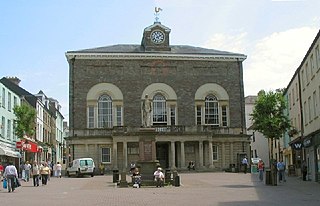
Carmarthenshire is a county in the south-west of Wales. The three largest towns are Llanelli, Carmarthen and Ammanford. Carmarthen is the county town and administrative centre. The county is known as the "Garden of Wales" and is also home to the National Botanic Garden of Wales.
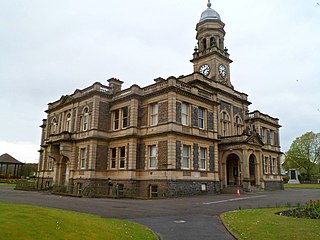
Llanelli is a market town and community in Carmarthenshire and the preserved county of Dyfed, Wales. It is located on the Loughor estuary and is also the largest town in the county of Carmarthenshire.

Carmarthen is the county town of Carmarthenshire and a community in Wales, lying on the River Towy 8 miles (13 km) north of its estuary in Carmarthen Bay. At the 2021 census the community had a population of 14,636, and the built up area had a population of 16,455. It stands on the site of a Roman town, and has a claim to be the oldest town in Wales. In the middle ages it comprised twin settlements: Old Carmarthen around Carmarthen Priory and New Carmarthen around Carmarthen Castle. The two were merged into one borough in 1546. It was the most populous borough in Wales in the 16th–18th centuries, described by William Camden as "chief citie of the country". It was overtaken in size by the mid-19th century, following the growth of settlements in the South Wales Coalfield.

Ammanford is a town and community in Carmarthenshire, Wales. At the 2021 census the community had a population of 5,445, and the wider built up area had a population of 8,285.

Kidwelly is a town and community in Carmarthenshire, southwest Wales, approximately 7 miles (11 km) northwest of the most populous town in the county, Llanelli. At the 2021 census the community had a population of 3,689.

Llandovery is a market town and community in Carmarthenshire, Wales. It lies on the River Tywi and at the junction of the A40 and A483 roads, about 25 miles (40 km) north-east of Carmarthen, 27 miles (43 km) north of Swansea and 21 miles (34 km) west of Brecon.

Company Sergeant Major Ivor Rees VC was a Welsh recipient of the Victoria Cross, the highest and most prestigious award for gallantry in the face of the enemy that can be awarded to members of the British and Commonwealth forces.

Llanelli is a constituency of the House of Commons of the Parliament of the United Kingdom. From 1918 to 1970 the official spelling of the constituency name was Llanelly. It elects one Member of Parliament (MP) by the first past the post system of election. Since 2005, it is currently represented by Nia Griffith of the Labour Party.

Cwmamman or Cwmaman is a community in Carmarthenshire, about 12 miles north of Swansea in southwest Wales. Literally meaning "Amman valley", it takes its name from the River Amman which runs through the area. The main settlements in the community are Glanamman and Garnant.
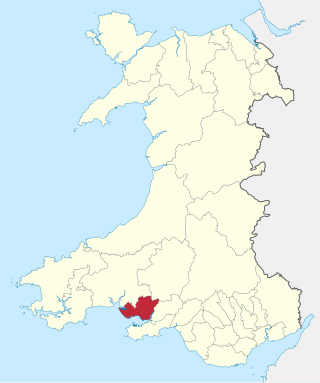
The Borough of Llanelli was one of six local government districts of the county of Dyfed, Wales from 1974 to 1996.
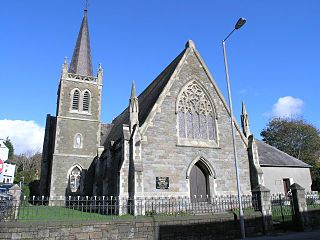
Hall Street Methodist and United Reformed Church is a local ecumenical partnership of two denominations in the original Methodist chapel in the town of Llanelli, Carmarthenshire, Wales. The present building was built in 1856 and is located in Hall Street. The chapel was designated as a Grade II listed building on 3 December 1992.

Aberystwyth Town Hall is a municipal structure in Queen's Square, Aberystwyth, Wales. The structure, which was the headquarters of Aberystwyth Borough Council, has operated since 2012 as a public library and a pensioners' day centre.

Carmarthen Guildhall is a municipal structure in Guildhall Square, Carmarthen, Wales. The guildhall, which was the headquarters of Carmarthen Borough Council, is a Grade I listed building.
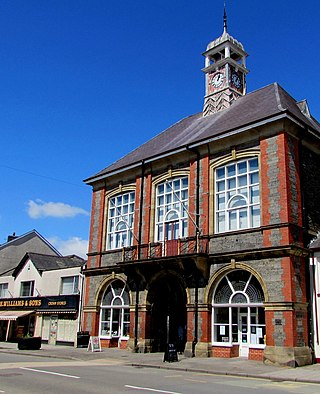
Lampeter Town Hall is a municipal structure in the High Street, Lampeter, Wales. The town hall, which was the meeting place of Lampeter Borough Council, is a Grade II listed building.

Llandovery Town Hall is a municipal building in Market Street, Llandovery in Carmarthenshire, Wales. The structure, which is used as the local public library, is a Grade II listed building.

Alban Square, in the centre of Aberaeron, Ceredigion, Wales is a range of early 19th century townhouses. The town of Aberaeron was developed around 1810 as a port by the Rev. Alban Thomas Jones Gwynne, a local landowner. After his father's death in 1819, Colonel A.T.J. Gwynne engaged Edward Haycock Sr. to plan a major expansion. Leases were sold in the early 1830s and Alban Square was designed, but largely unbuilt, by 1834. The town grew as a centre for shipbuilding and commerce. The expansion of the railways, and their arrival in Aberaeron in 1909 brought these commercial endeavours to an end and the town became a seaside resort and a centre for local government. No.s 9-20 inclusive on Alban Square are Grade II* listed buildings, their Cadw listing records describing the square as "a well preserved terrace in a key location".

Portland Place, in the centre of Aberaeron, Ceredigion, Wales is a terrace of mid-19th century townhouses. The town of Aberaeron was developed around 1810 as a port by the Rev. Alban Thomas Jones Gwynne, a local landowner. After his father's death in 1819, Colonel A.T.J. Gwynne engaged Edward Haycock Sr. to plan a major expansion. Leases were sold in the early 1830s and development continued for much of the rest of the 19th century, the town growing as a centre for shipbuilding and commerce. The expansion of the railways, and their arrival in Aberaeron in 1909 brought these commercial endeavours to an end and the town became a seaside resort and a centre for local government. No.s 1-7 inclusive on Portland Place are Grade II* listed buildings, forming "the finest single terrace" in Aberaeron.

Kidwelly Town Hall is a municipal building in Lady Street, Kidwelly, Carmarthenshire, Wales. The structure, which was last used as a public library but is currently vacant, is a Grade II listed building.

The Shire Hall is a municipal building in Carmarthen Street, Llandeilo, Carmarthenshire, Wales. The structure, which was used as a courthouse for over a century, is now the meeting place of Llandeilo Town Council.

Ammanford Town Hall is a municipal building located on Iscennen Street in Ammanford in Carmarthenshire in Wales. The structure is currently used as the offices and meeting place of Ammanford Town Council.





















